
New Items - Photos, page 4
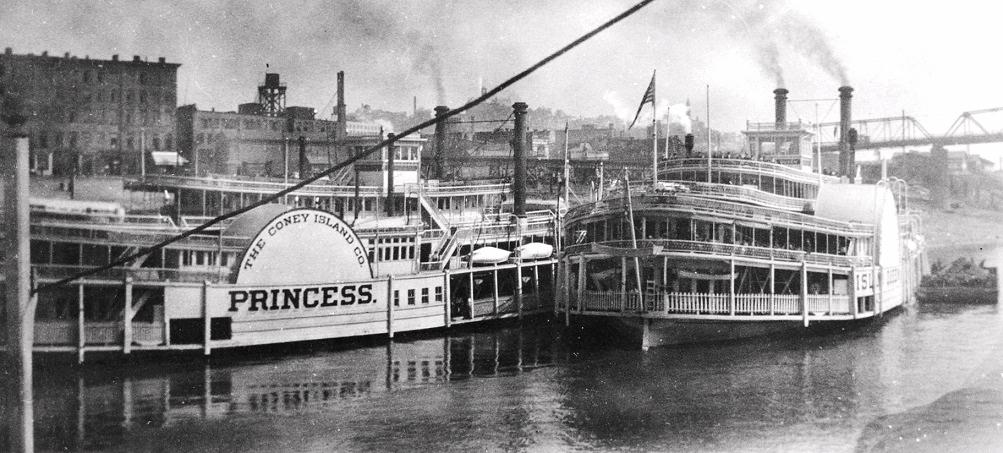
PRINCESS & ISLAND QUEEN 1915
Island Queen and Princess
Photo of the PRINCESS, left and ISLAND QUEEN right taken April 30, 1915
ISLAND QUEEN
Sidewheel Excursion boat
Way's Packet Directory Number 2799
Built at Cincinnati, Ohio, by Cincinnati Marine Railway Company, 1896
Owned by : The Coney Island Company, Cincinnati, Ohio
OFFICERS & CREW in 1896:
Captain Sterling McIntyre, master
Captain James DuPuy mate, later became master
Captain Ben I. Pattison, became master after Captain DuPuy
Harry and Wes Doss, pilots
Homer Denney played the calliope
Ran on the Ohio; Mississippi and Kentucky rivers
Reported to have a carrying capacity of 4000, she operated between Cincinnati and the Coney Island amusement park upstream; her partner boat in the Coney run was the Princess until 1918, and then the Morning Star.
The Island Queen tramped in off seasons, was at New Orleans but never above Pomeroy on the Ohio.
In January 1918 she broke loose in the ice and drifted below Madison, Indiana, where she was safely landed and taken to the Louisville Canal.
Upbound from Cincinnati to Point Pleasant on April 27, 1922, during a marine celebration of the centennial of the birth of U. S. Grant, the forward hurricane deck collapsed, injuring 28 boys.
The Island Queen and her partner boat Morning Star burned at Cincinnati, along with the Tacoma and Chris Greene at Cincinnati, Ohio, November 4, 1922.
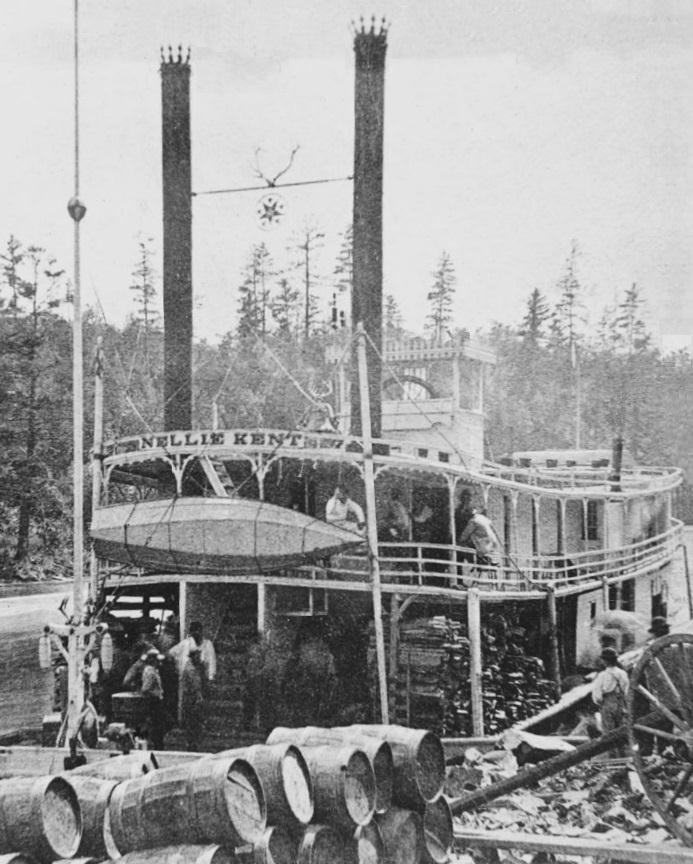
NELLIE KENT, photo take near Taylors Falls, Minnesota
NELLIE KENT
Way's Packet Directory Number 4137
Sternwheel Packet
Built by John Kent in 1868 at Osceola, Wisconsin (hull); completed at La Crosse Wisconsin.
Owned by Captain William Kent
First home port, St. Paul Minnesota. Ran on the St. Croix River.
She ran between Prescott and St. Croix Falls.
She ran tri-weekly from St. Paul to Taylors Falls.
Dismantled in 1879 and her equipment went to building the MARY BANES
Officers & Crew in 1871:
Captain William Kent, master
Captain Russ Ruley, pilot;
Captain Oscar Knapp master
John A. Kent, pilot
David Cunningham, steward
Thomas J. Connelly, engineer
Robert Hill, carpenter
Mark Humphrey, first clerk
From the La Crosse collection
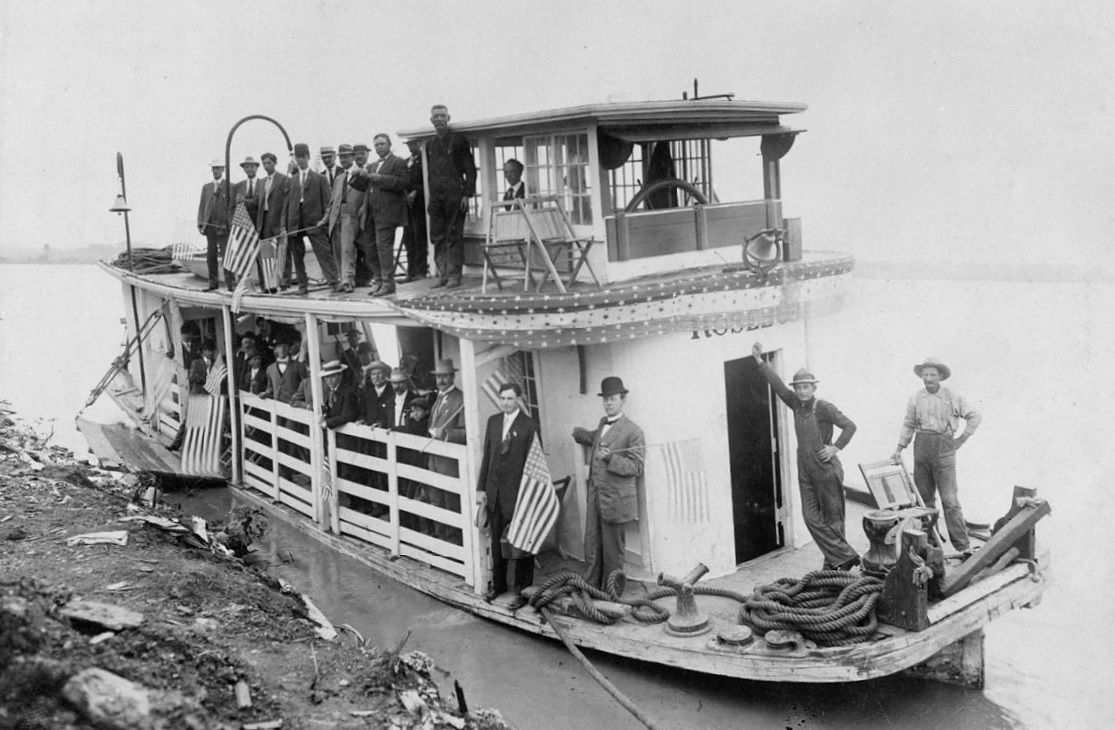
Rose Bud (or ROSEBUD)
Sternwheel Packet (has towing knees on her bow so could've served as a towboat also)
Photo taken at Pierre, South Dakota on the Missouri River in 1909
From La Crosse collection
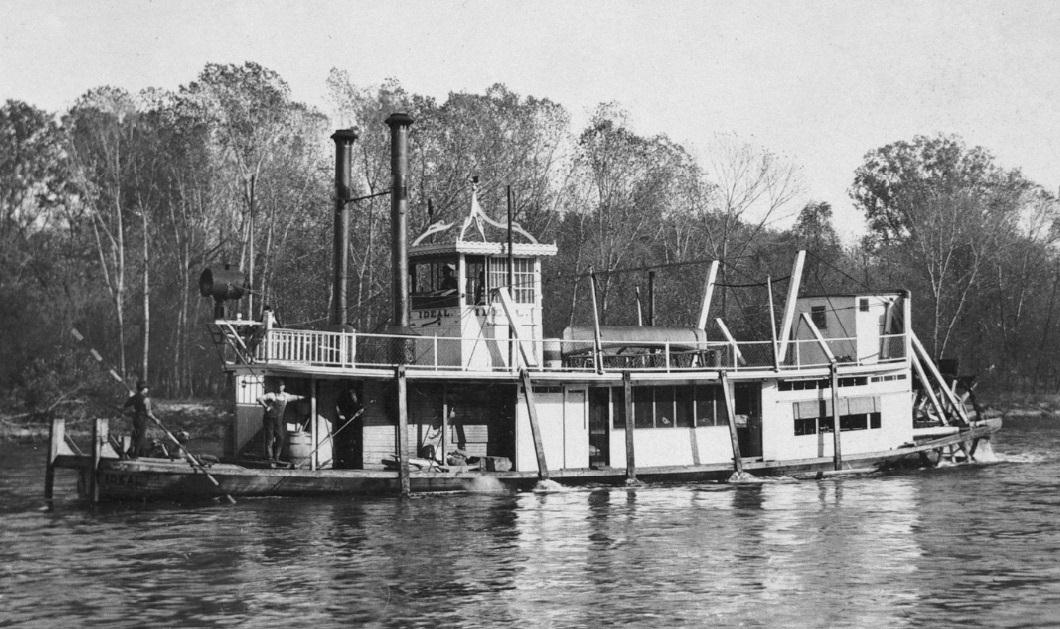
Sternwheeler IDEAL
Sternwheel Packet
Way's Packet Directory Number 2724
Built in 1905 at Clinton, Iowa as the "H.L." but her name was changed to "IDEAL" because local boys could
too easily change her name to "H E L L" on posters promoting her excursions.
Owned by F.J. Fugina in 1917.
Ran excursions along the upper Mississippi using her towing knees to push the ALICE, an excursion barge.
For fifteen years she operated as a daily packet between Winona, Minnesota and Fountain City, Wisconsin.
On Saturdays and Sundays she also took out excursions. She was still documented in 1918.
Captains Harry Short and Elsie R. Karnath (1913)
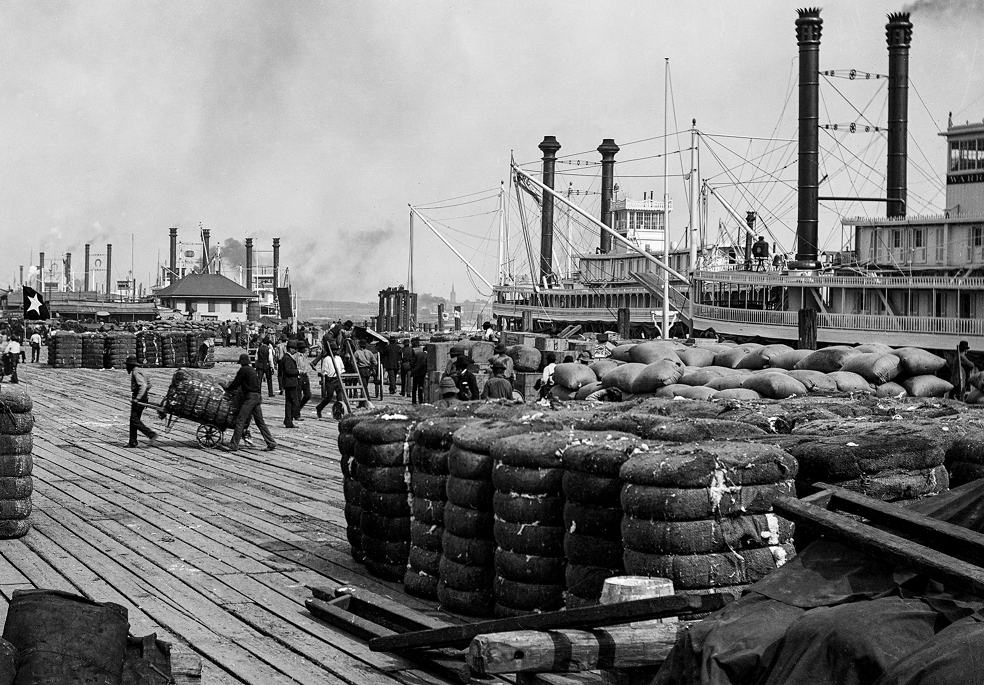
"Cotton on the levee at New Orleans" 1890 by William Henry Jackson.
Detail from a 5 x 7 inch glass negative on SHORPY.
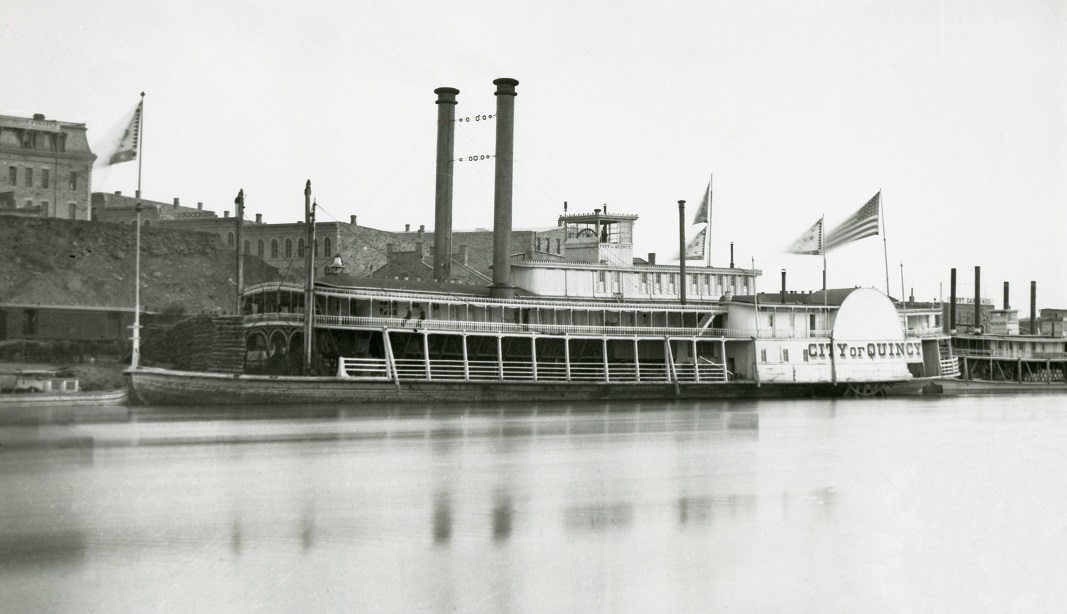
CITY OF QUINCY Sidewheel steamboat
Way's Packet Directory Number 1127
City of Quincy
Sidewheel steamboat
Construction was begun in 1871 at Madison, Indiana then completed at New Albany, Indiana.
275 x 47 x 7 feet
In June 1871 she made a trip from New Orleans to St Paul, Captain Judson T West.
Ran St Louis - New Orleans and occasionally St. Louis - Keokuk.
In April - May 1875 was loaded with ore near St. Louis and, towing two barges also loaded with ore, traveled to Steubenville, Ohio.
She proceeded to Pittsburgh and at Painter's Mill she took on 300 tons of cotton ties got a trip at the wharf, and returned.
The TOM JASPER also was up the Ohio with iron ore at this time. She sank at Island 98, Mississippi River, January 21, 1875, raised. Finally lost at Hardin's Point, Arkansas, 75 miles below Memphis, then owned by the City of Quincy Transportation Co., under Captain William F. Davidson and others.
The BELLE OF TEXAS removed furnishings and brought the piano, etc., to Memphis This happened on Feb. 13, 1876, at 8:00 pm during a tornado which blew her to the Mississippi shores.
The IDLEWILD was in the vicinity and took off the passengers and crew.
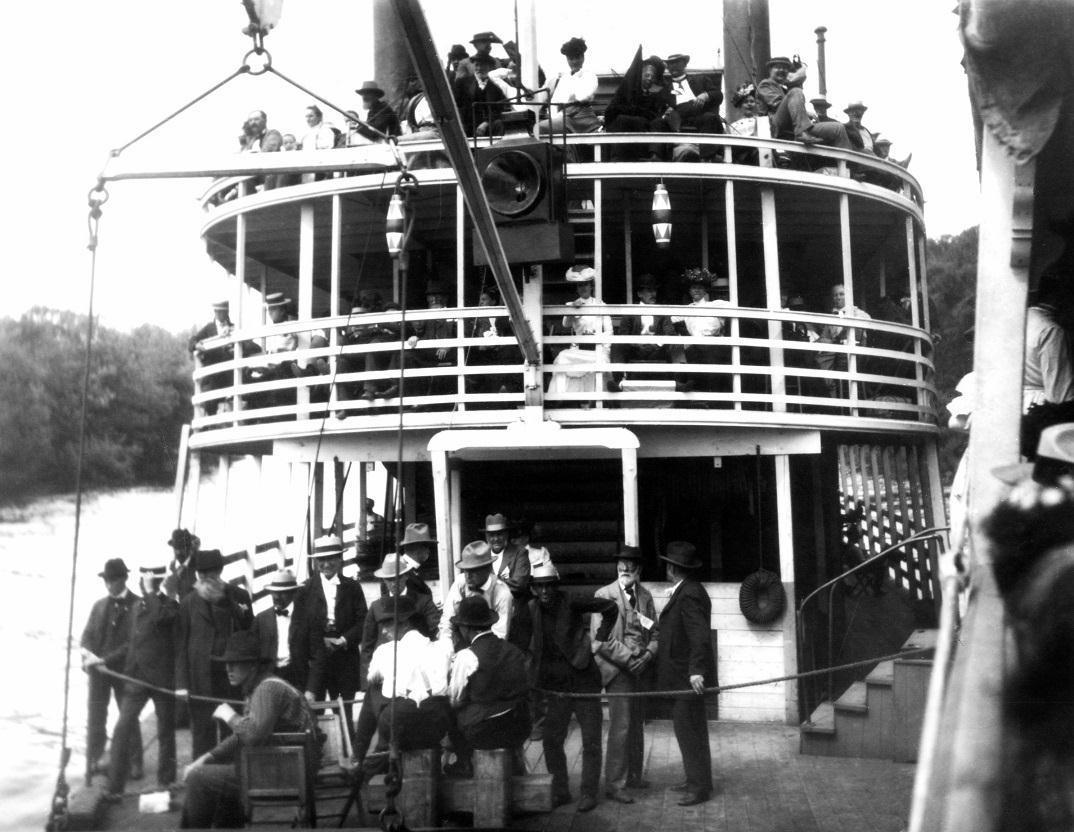
Unidentified excursion steamboat with a congregation of 16 gents on the main deck and above there is a mix of ladies and gents on the boiler deck and "hurricane roof." Another steamer or a barge for overflow passengers is alongside far right. A short set of "stairs" lower right may have been intended to give easy access between passengers in the steamboat and the barge.
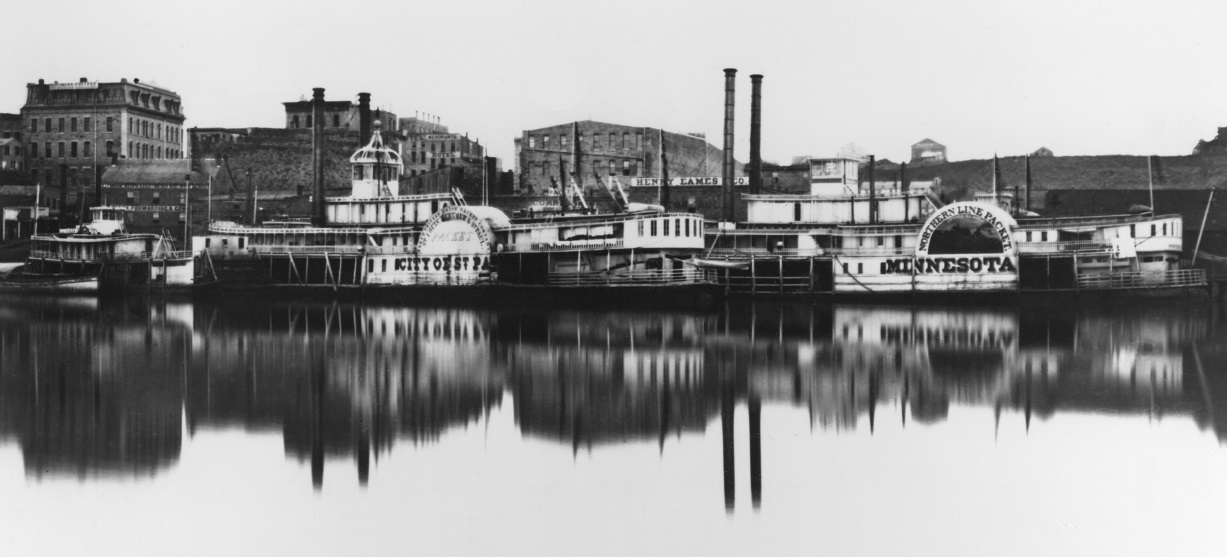
Steamers City of St. Paul & Minnesota photographic Panorama
CITY OF ST. PAUL
Way's Packet Directory Number 1133
Sidewheeler built at La Crosse, Wisconsin in 1866
220 x 36 x 6 Engines 21's - 7feet. Three boilers each 42 inches by 26 feet.This was a rebuilding job, using much from the former MOSES McLELLAN. Operated on the Upper Mississippi and was inspected at St. Paul in 1867.
MINNESOTA
Way's Packet Directory Number 3952
Sidewheeler built at Wheeling West Virginia in 1866. She was advertised out of Pittsburgh on April 3rd, 1866, under Captain Thomas B. Hill with Charles C. Carrell, clerk. Was in the Northern Line. Hit the Clinton bridge on May 18th, 1867 and was drydocked at LeClaire, Iowa. In the Summer of 1881 she was rebuilt into a railroad transfer and renamed TRANSFER No. 2.
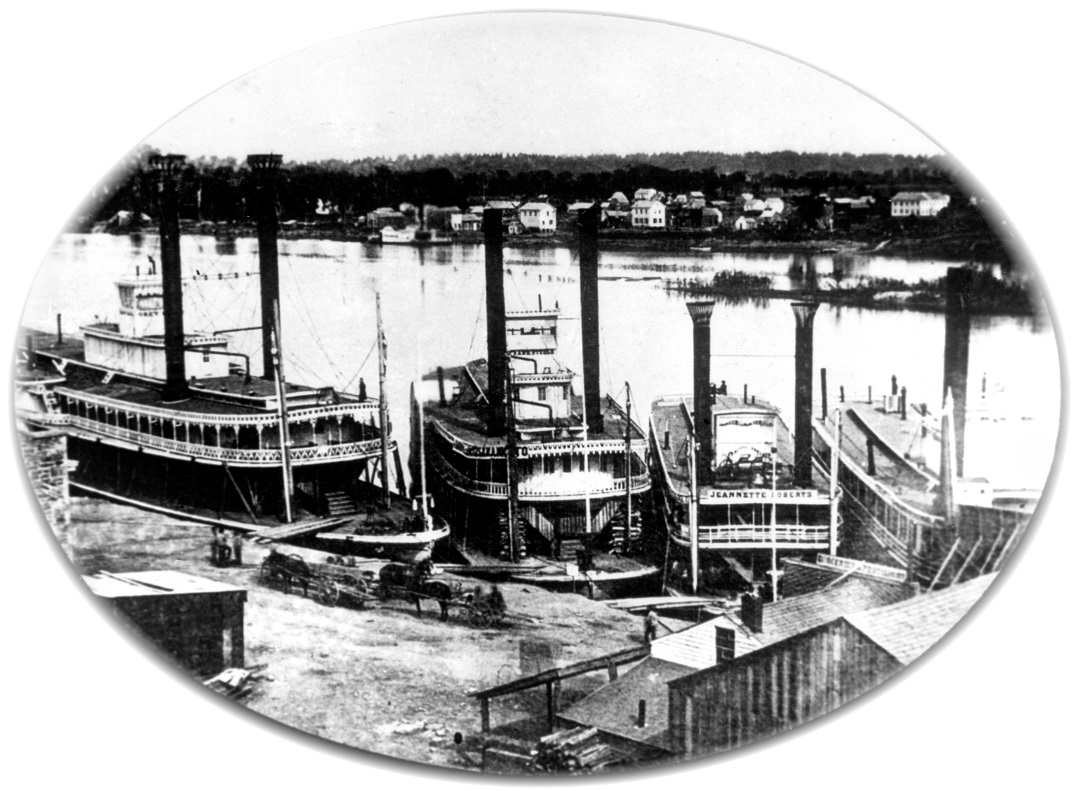
Steamers at St Paul 1856 Grey Eagle, Frank Steele, Jeanette Roberts and Time & Tide
Steamboats at St. Paul circa 1856
Upper Mississippi Valley Photo Archive
umvphotoarchive.org
View looking down on four steamboats with their bows tied to shore and sterns pointed down river. Buildings and two horse-drawn vehicles on levee. River and far riverbank lined with buildings in background. Boats are the GREY EAGLE, FRANK STEELE, JEANETTE ROBERTS and TIME & TIDE.
St. Paul, Ramsey County, Minnesota
Putnam Museum of History and Natural Science
The Putnam Museum was founded in 1867 and holds extensive photographs and archival collections that document regional history. Specific subject strengths of the photograph collection include steamboats, local businesses and portraits of Quad-City area individuals and families taken by the Free studio of Photography from 1915-1950.
The Putnam Museum
1717 West 12th Street
Davenport, Iowa.
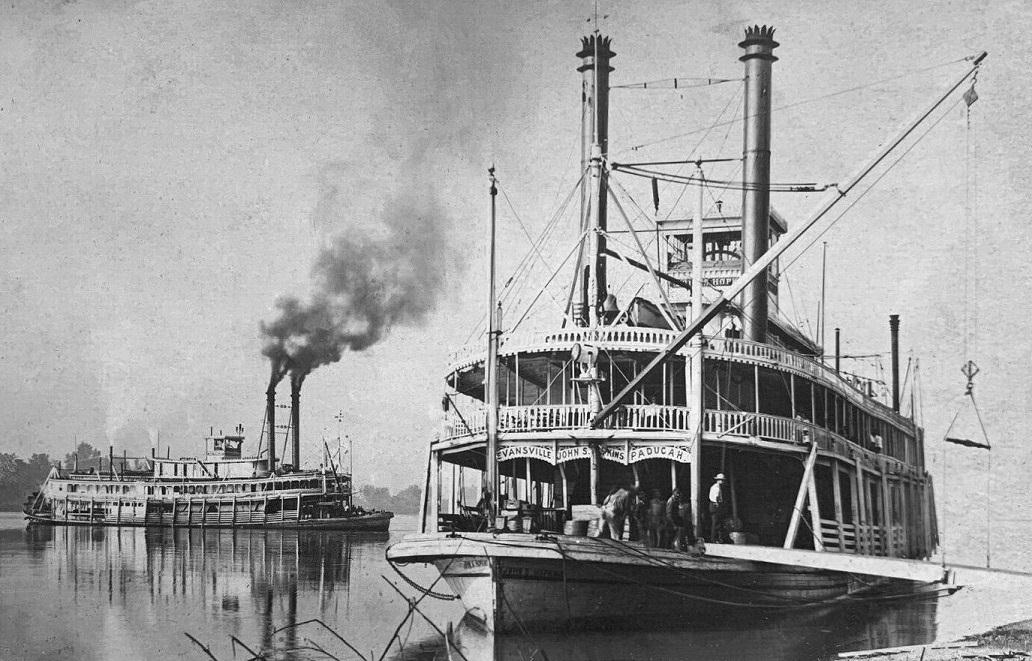
Steamers JOHN S. HOPKINS (right) and JOE FOWLER
JOHN S. HOPKINS
Sternwheel Packet/Excursion steamboat
Way's Packet Directory Number 3110
Built in 1880, the hull at Sewickley, Pennsylvania and completion at Pittsburgh.
Owned by the Evansville, Paducah & Cairo Mail Line; Ran on the Ohio, Cumberland and Green rivers
Most of her years, she ran the Evansville-Paducah line.
Damaged by fire in 1882, she was completely rebuilt at Cincinnati.
In April 1912, Captain J.B. Thompson converted her into an excursion boat.
She burned while laid up in the Green River in January, 1917.
Officers and crew:
Captains Joe and Dick Fowler; Captain H.C. Gilbert (master), W.D. Newbill (clerk); 1905: Sam G. Smith (clerk)
JOE FOWLER (background, left)
Sternwheel Packet
Way's Packet Directory Number 3031
Built in 1888 at Jeffersonville, Indiana by Howard Ship Yard
OWNERS:
Fowler family; U.S. mail boat
Captain Ben S. Pope (1912)
Captain John L. Lowry (circa 1917)
Captain Jeff H. Williams
Ran the Ohio, Mississippi River and Cumberland rivers
Built for the Evansville-Paducah trade where she teamed up with the JOHN S. HOPKIN. The original price was $20,800; home port or owner's residence in 1888 was Paducah, Kentucky.
In May 1895, she had completed seven years with a total of 327,000 miles as a U.S. mail steamer. She had carried about 152,400 passengers without any loss of life. She continued in this trade until she wore out and was condemned. She was sold in early spring of 1912 and completely rebuilt at Parkersburg, West Virginia.
After being rebuilt she made her first trip in April 1913 from Parkersburg to Pittsburgh. In summer 1913 she ran excursions in the Wheeling-Bellaire area. She ran a Mardi Gras cruise from Parkersburg to New Orleans and returned to Pittsburgh in early 1914. She ran a special cruise, Pittsburgh-St. Paul, Minnesota and returned to Louisville in June 1914. In the summer of 1914, she ran excursions at Louisville. In 1915 she ran Pittsburgh-Louisville, the round trip being completed in one week. She carried a calliope which was played by Gus Fissmer of Louisville. The average cost per round trip was $1,100 and she burned 3,000 bushels of coal a week. In 1916 she ran excursions in the Parkersburg-Pittsburgh area. In January 1917, she came to Ambridge, Pennsylvania to get new barges for delivery south. After she was converted into the excursion boat CRESCENT in 1919, her original whistle was transferred to the RUTH.
Officers & Crew:
1888: Captain James Damron (master)
1913: Captain Martin F. Noll (purser)
1914:
Captain Elmer E. Pope (manager)
Captain A.C. Dunbargar (master)
Clyde Packard (purser)
Clarence L. Cunningham (chief engineer, 1914)
Earl Cooper (electrician, 1914)
Walter S. Conner (pilot, 1914)
Stuart Conner (pilot, 1914)
Captain Walter Blair; Donald T. Wright (clerk);
Captain William C. Lepper
1914 -15
Bill Sampson (steward)
Dayton Randolph (pilot)
1915:
Captain Ben S. Pope (master)
Walter English (pilot)
Jack Speers (clerk)
Earl Cooper (clerk)
William English (mate)
Gus Fissmer (calliope player)
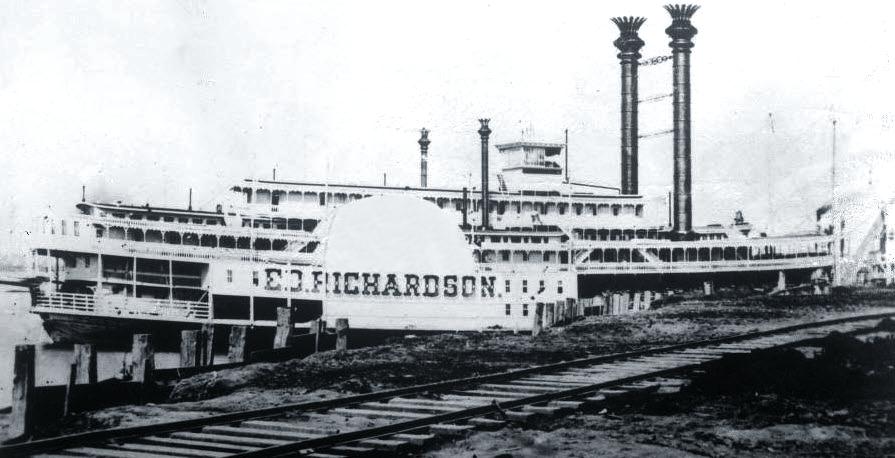
The sidewheeler ED RICHARDSON in 1884
309 x 49 x 12 feet, was built in 1878 with a wooden hull.
Owned by Capt. John W. Cannon, she operated on the lower Mississippi River.
One of the finest packets during the age of floating palaces, she was dismantled in 1888.

Dean Cornwell's "Canal Days," depicted Roscoe Village, Ohio in the 1830's
Found a 5.60 x 17.25 inch print of Dean Cornwell's "Canal Days" 8 x 24 foot mural, scanned the left and right halves and cobbled them together in Photoshop. Text below is from the Roscoe Village site: roscoevillage.com
Roscoe Village during the 1830's came to life in an idyllic painting by renowned illustrator and muralist Dean Cornwell in which he vibrantly captured life on the banks of the Ohio and Erie Canal in a 24-by-8 foot mural to commemorate the sesquicentennial celebration of the founding of Coshocton, Ohio.
"Canal Days," which depicts the Roscoe area and can be seen in the Chase Bank building, at 120 S. Fourth Street, captured the imagination of the prominent Coshocton industrialist, Edward E. Montgomery.
Inspired, Montgomery and his wife, Frances, purchased the 1840 Toll House in 1961 and endeavored to revive, restore and reclaim the then burgeoning port town to a time when the Ohio and Erie Canal bustled with boats and barges.
The port town that was to become Roscoe was laid out in 1816 after a bankrupt merchant bet that rural farmers would rather do business there than have to shell out 25 cents for the ferryboat to Coshocton. On the heels of that hunch, James Calder set up shop across the Muskingum River and named the spot Caldersburgh after himself. Caldersburgh was renamed Roscoe in 1830 in honor of William Roscoe, an English historian and a leading abolitionist of the time.
The construction of the Ohio and Erie Canal in the 1820s was a boon to the burgeoning village. The first canal boat, the Monticello, landed at Roscoe on August 21, 1830.
Roscoe became the fourth largest wheat port on the 350-mile canal system that stretched from the Great Lakes to the Hudson River.
Roscoe thrived until the 1860s, when the canals gave way to the railroads. Although the canal system continued to operate, Roscoe steadily ceded its position until the once-prosperous port town was swept away in the Great Flood of 1913.
Today, the restored Roscoe Village stands as a testament to Ohio's bygone Canal era. Edward E. Montgomery created what he called, "a living museum, so that people of the 20th century and beyond could enjoy a 'step back in time' to the 19th century where aged brick buildings, costumed interpreters and quaint shops bring the canal era back to life." The picturesque Roscoe Village has become a major tourist destination in Ohio.
The Great Flood of 1913 washed over several states between March 23 and 26, and left over a quarter-million people homeless. The Great Flood of 1913 lingers as Ohio's largest weather-related disaster.
The Visitor Center
600 N. Whitewoman Street
Coshocton, Ohio 43812
Welcome to Historic Roscoe Village - Coshocton, Ohio
Youtube
Visit Roscoe Village ~ a top Ohio tourist destination Roscoe was once a bustling port along the Ohio and Erie Canal. Now it is a top Ohio tourist destination and one of the region's most beautiful areas to visit.

With the exception of images credited to public institutions,
everything on this page is from a private collection.
Please contact Steamboats.com for permission for commercial use.*
All captions provided by Dave Thomson, Steamboats.com primary contributor and historian.
